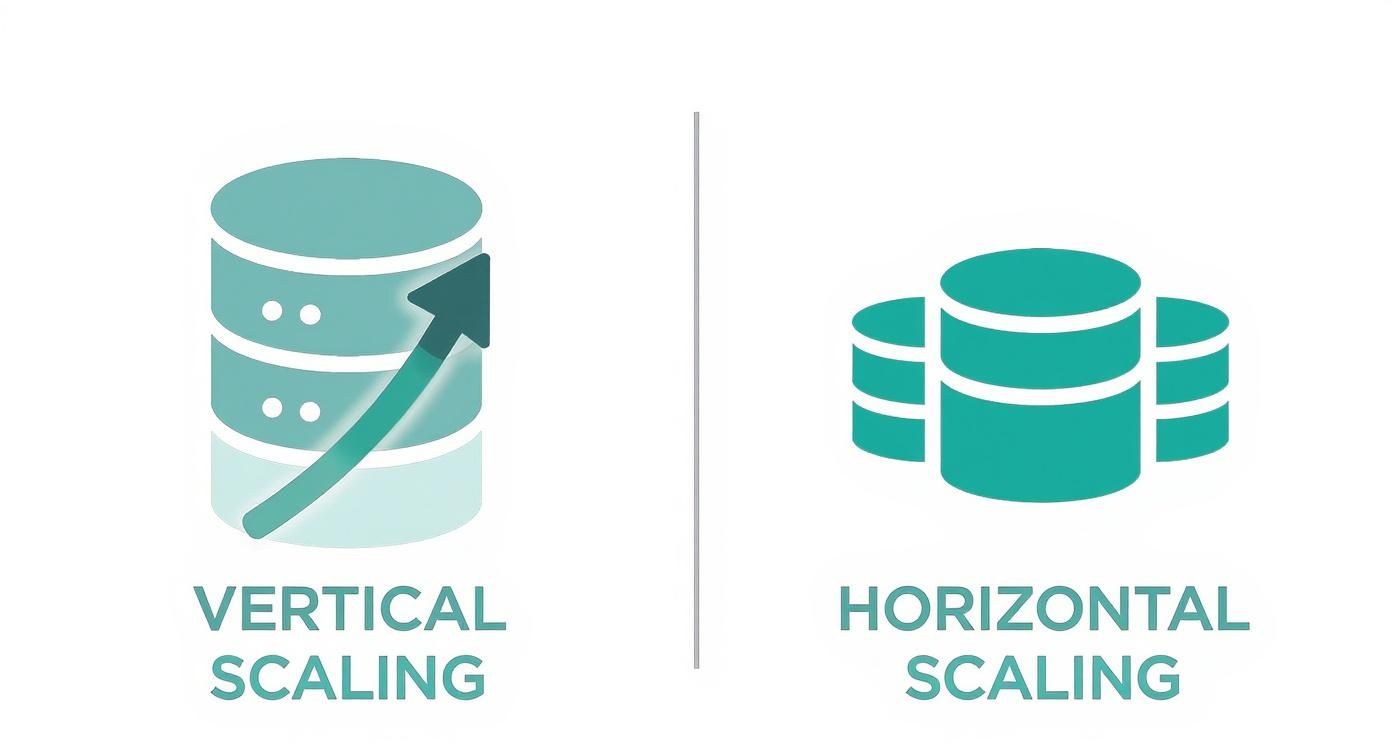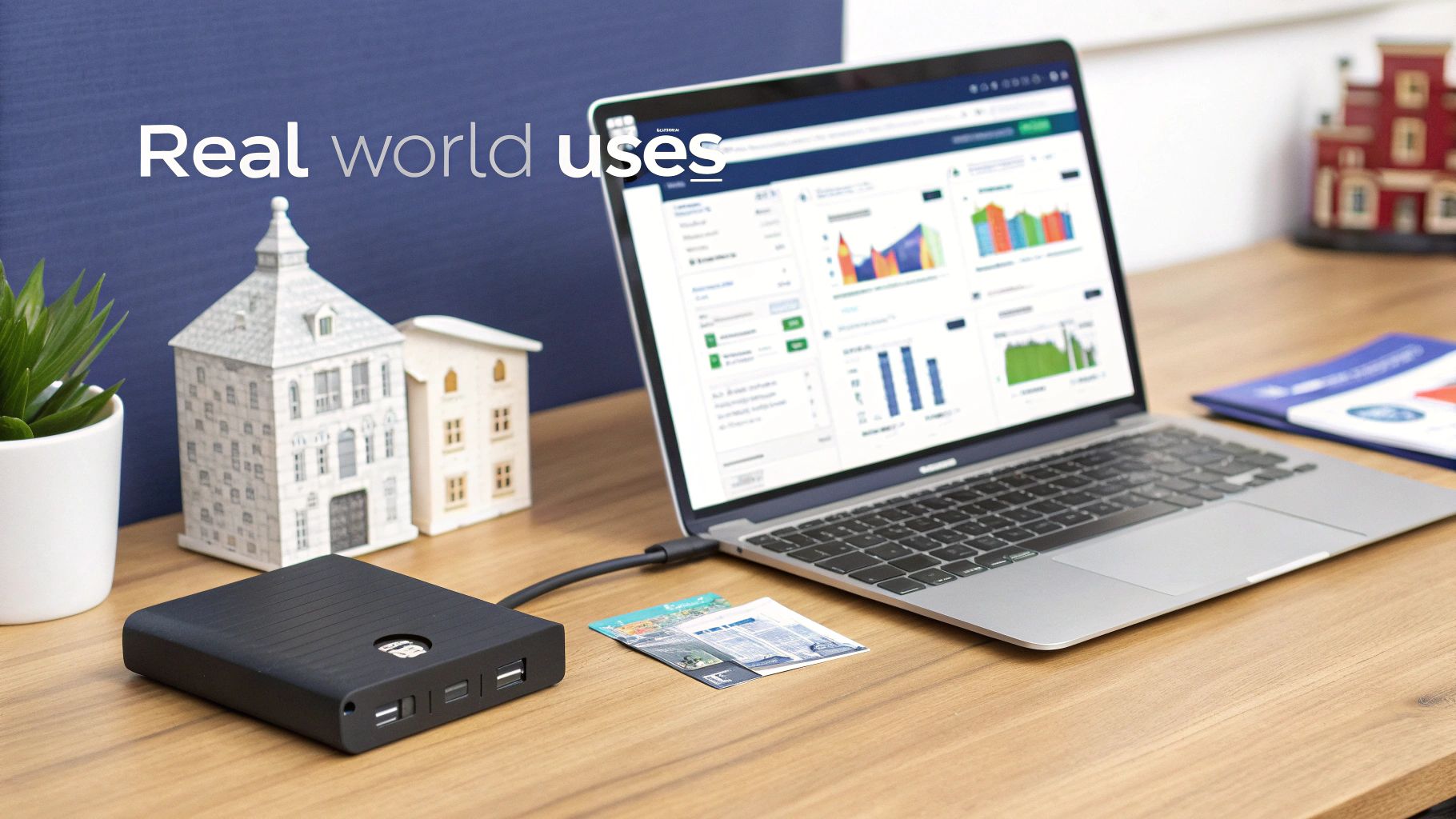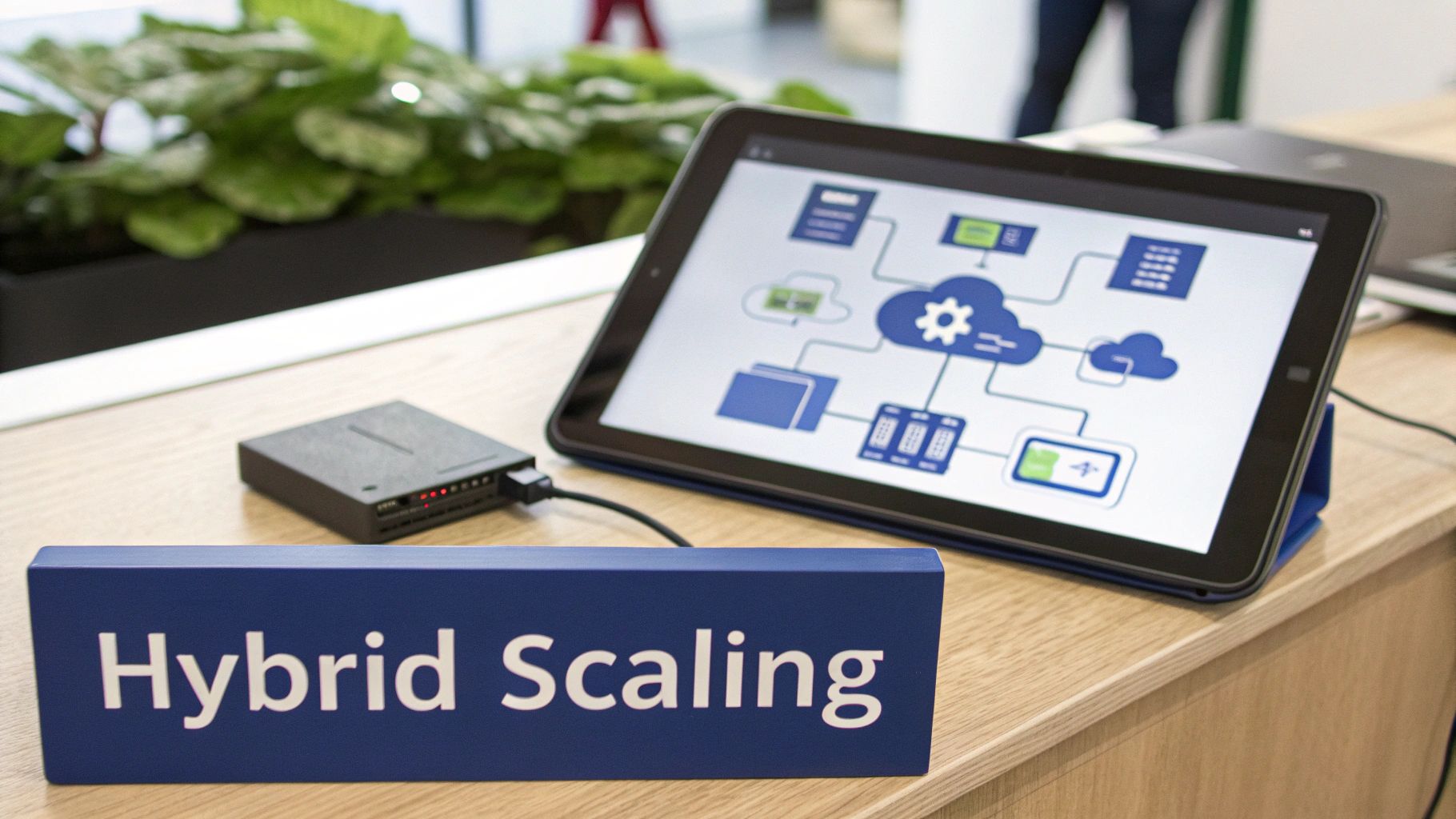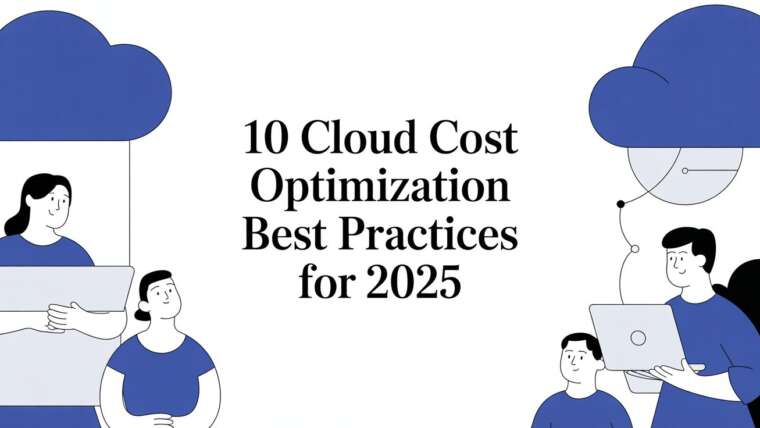When your application starts getting more traffic, you’re faced with a simple choice: do you make your current server more powerful, or do you just add more servers? That's the core difference between vertical scaling vs. horizontal scaling.
Think of vertical scaling as upgrading your existing machine with more power, like adding more RAM or a faster CPU. In contrast, horizontal scaling is all about adding more machines to your network, spreading the workload across them.
Foundational Scaling Concepts
Figuring out how to scale your infrastructure is absolutely critical. Get it right, and you maintain great performance, keep costs in check, and handle traffic spikes without a hitch. Get it wrong, and your users will face slowdowns, or worse, complete outages when your system gets overwhelmed.
Scaling is all about boosting your system's capacity to meet demand. The two main ways to do this are vertical and horizontal scaling, and each one comes with its own set of rules and consequences.
Vertical Scaling Explained
Vertical scaling, often called scaling up, is all about beefing up a single machine. It’s a lot like upgrading your personal computer. When it gets slow, you add more RAM, drop in a more powerful processor, or slap in a bigger hard drive.
This approach is usually the simpler one to implement because you don't have to re-architect your application to make it work.
- Method: Increase resources (CPU, RAM, storage) on one server.
- Simplicity: It’s generally less complex from an architectural standpoint.
- Limitation: You're ultimately capped by the maximum power a single machine can handle.
A classic example is upgrading a cloud database server. You might go from an instance with 8 vCPUs and 32 GB of RAM to a much beefier one with 32 vCPUs and 64 GB of RAM. For a deeper dive into these strategies, you can find more great insights on prosperops.com.
Horizontal Scaling Explained
Horizontal scaling, or scaling out, takes a completely different approach. Instead of making one machine a superhero, you add more machines to the team. This builds a distributed system where the work is shared across multiple servers.
This is the bedrock of modern, high-availability applications designed to serve millions of users without breaking a sweat.
- Method: Add more machines to distribute the workload.
- Resilience: It naturally creates fault tolerance. If one machine goes down, the others just pick up the slack.
- Scalability: The capacity is almost limitless; you can just keep adding more nodes.
Here’s a quick table to break down the key differences.
| Feature | Vertical Scaling (Scale Up) | Horizontal Scaling (Scale Out) |
|---|---|---|
| Approach | Adds resources to a single server | Adds more servers to a system |
| Complexity | Lower architectural complexity | Higher initial complexity |
| Fault Tolerance | Single point of failure | High availability and resilience |
| Performance Limit | Capped by single machine's capacity | Nearly limitless with more nodes |
Comparing Key Differences in Scaling Methods
Moving beyond the basic definitions, the real choice between vertical and horizontal scaling comes down to understanding their fundamental trade-offs. Each approach impacts your system's performance, resilience, cost, and complexity in profoundly different ways. Making the right call means taking a clear-eyed look at these distinctions.
Vertical scaling is almost always simpler to get started with. You’re just working with a single, more powerful machine, which means all the communication between your application's components is lightning-fast and direct. But that simplicity creates a major risk: a single point of failure.
This infographic gives you a great visual summary of the single-server approach of vertical scaling versus the distributed model of horizontal scaling.

The image really drives home the core architectural difference. Scaling up means beefing up one machine, while scaling out means multiplying the number of machines to build a more resilient system.
Performance and Implementation Complexity
On the performance front, vertical scaling gives you very low latency for any process that has to run on one machine, simply because there’s no network overhead to worry about. The big catch is the hard ceiling on resources; you can only upgrade a single server so much before it becomes outrageously expensive or just physically impossible.
Horizontal scaling, on the other hand, offers almost limitless potential for handling traffic. By just adding more machines, you can distribute the load pretty much indefinitely. This distribution, however, introduces a whole new layer of architectural complexity, demanding tools like load balancers to route traffic and make sure all the nodes are working together seamlessly.
The real game-changer is how each model handles failure. With vertical scaling, if your one big server goes down, your entire application is offline. Period. Horizontal scaling has fault tolerance baked right in; if one node fails, the others just pick up the slack, ensuring high availability.
Cost Efficiency and Long-Term Growth
The cost picture for vertical vs. horizontal scaling is nuanced and definitely changes over time. At first glance, just upgrading your existing server (scaling up) might seem cheaper than buying a bunch of new ones.
But the cost of high-end, powerful hardware doesn't just go up; it goes up exponentially. A study by Enterprise Management Associates and BigPanda found that downtime costs companies an average of $12,900 per minute. That's a massive risk baked into any vertically scaled system with its single point of failure.
- Vertical Scaling Cost: You start with a lower initial investment, but the costs skyrocket for top-tier hardware. The risk of incredibly expensive downtime is also much higher.
- Horizontal Scaling Cost: The upfront costs for multiple servers and networking gear are higher, but it often becomes much more cost-effective at a massive scale, especially when using standard commodity hardware. It also gives you much finer control over costs with auto-scaling.
When you think about long-term growth, horizontal scaling is almost always the more sustainable choice. It lets a system grow step-by-step and reliably without ever hitting a hard physical limit. This is the foundational idea behind how modern, cloud-native applications are built, designed for resilience and massive scale from day one.
A vertically scaled system, in contrast, will eventually hit a wall. When it does, you're forced into a difficult and expensive architectural migration to a distributed model. Choosing the right path from the start saves a world of pain, time, and money down the road.
Vertical vs Horizontal Scaling At a Glance
To make the comparison crystal clear, let's break down the core differences in a simple table. This will help you quickly see how each approach stacks up across key attributes.
| Attribute | Vertical Scaling (Scale Up) | Horizontal Scaling (Scale Out) |
|---|---|---|
| Method | Increase resources (CPU, RAM) on a single server. | Add more servers (nodes) to a cluster. |
| Complexity | Simpler to implement and manage initially. | More complex; requires load balancing and distributed logic. |
| Scalability Limit | Limited by the maximum capacity of a single machine. | Virtually limitless; can scale by adding more machines. |
| Fault Tolerance | Low. Creates a single point of failure. | High. Failure of one node doesn't bring down the system. |
| Performance | Low latency within the single machine. | Can handle massive concurrent traffic, but network latency is a factor. |
| Initial Cost | Often lower for small-scale needs. | Can be higher due to multiple servers and infrastructure. |
| Long-Term Cost | Becomes exponentially expensive at the high end. | More cost-effective at large scale using commodity hardware. |
This table neatly summarizes the trade-offs. Vertical scaling offers simplicity but comes with inherent risks and limits, while horizontal scaling provides resilience and massive scale at the cost of increased complexity. Your specific application needs and growth plans will determine which model is the right fit.
Real World Use Cases for Each Scaling Strategy
Theory is great, but seeing how these scaling strategies solve actual business problems is where the rubber meets the road. The choice between vertical scaling vs horizontal scaling almost always comes down to your application's architecture and the kind of traffic you expect. Some situations are a perfect fit for one, and a total mismatch for the other.

Let's break down these use cases to connect the concepts to your own architectural headaches.
When to Choose Vertical Scaling
Vertical scaling really shines when single-threaded performance and simplicity are your top priorities. It's the natural choice for applications that were never designed to be distributed across multiple machines in the first place.
A classic example is a monolithic relational database. Think of a traditional PostgreSQL instance. It often relies on a single, beefy machine to manage complex transactions and guarantee data consistency. Scaling up by adding more CPU and RAM is the most direct way to improve its performance without a massive re-architecture project.
Vertical scaling is also the right move for:
- Legacy Systems: Plenty of older, business-critical applications were built as single, monolithic units. Trying to scale them horizontally would mean a complete and incredibly expensive rewrite. Upgrading their hardware is a far more practical, immediate fix.
- Stateful Applications: Any system that needs to maintain session data, like some authentication servers or real-time messaging backends, is just simpler to manage on one powerful node. This avoids all the headaches of synchronizing state across a cluster of machines.
- Compute-Intensive Tasks: Applications doing heavy, single-threaded number crunching, like certain scientific simulations or specific data analysis jobs, get a direct performance boost from a faster CPU and more memory on one machine.
Vertical scaling is often the path of least resistance for systems where architectural change is difficult or impossible. It provides a straightforward performance boost by enhancing the resources of a single server, making it ideal for centralized workloads.
When to Choose Horizontal Scaling
Horizontal scaling is the engine behind most modern, large-scale web applications. Its power lies in distributing workloads, making it perfect for handling unpredictable traffic spikes and ensuring your service stays online.
E-commerce websites are the quintessential example. During a Black Friday sale, traffic can explode by 100x or more in a matter of minutes. Horizontal scaling lets these platforms spin up dozens or even hundreds of extra web servers to handle the flood of shoppers. When the sale ends, they scale back down to save money. This dynamic response depends on a smart system to direct traffic, and you can learn more about how that works with effective load balancing in AWS.
This strategy is also a must-have for:
- Microservices Architectures: Modern applications built from many small, independent services are born to scale out. If your payment service gets hammered, you can just add more instances of that one service without touching anything else in the system.
- Big Data Processing: Frameworks like Apache Hadoop and Spark are fundamentally designed for horizontal scaling. They chop up massive data processing jobs and spread them across a cluster of commodity machines, which is how they can efficiently analyze terabytes or even petabytes of data.
- Content Delivery Networks (CDNs): To get content to users around the globe with low latency, CDNs run a massive, horizontally scaled network of servers. When you stream a video, you're almost certainly pulling it from a server that's geographically close to you, one small part of a huge distributed system.
How to Choose the Right Scaling Approach
Picking between vertical and horizontal scaling is a major architectural decision. Get it right, and you set yourself up for smooth performance and a healthy budget. Get it wrong, and you could be facing performance bottlenecks or costly overhauls down the road.
There’s no single "best" answer here. The right strategy comes down to your specific application, your budget, and your goals for the future. The best way to figure it out is to ask the right questions upfront.
Check Your Application Architecture
First things first, you need to look at how your application is built. The big question is whether it's stateful or stateless. A modern, stateless application, think microservices, treats every request like a brand-new interaction. It doesn't need to remember anything from the last one. This design is a perfect match for horizontal scaling because any server can handle any request, making it easy to just add more machines to the pool.
On the other hand, a stateful application, like a traditional relational database or an older monolithic system, needs to hang on to user data from one session to the next. This makes horizontal scaling a real headache, since you'd have to build a complex system for sharing that "state" across different machines. For these kinds of systems, vertical scaling is usually the simpler, more direct path forward.
Dig Into Your Budget and Cost Model
Your budget is a massive factor in this debate. At first glance, vertical scaling can seem cheaper; you’re just beefing up an existing server. But the cost of high-end hardware doesn't just go up, it goes up exponentially. And you’re stuck paying for that peak capacity 24/7, whether you’re actually using it or not.
Horizontal scaling might have a higher initial setup cost, since you need multiple machines and a load balancer to distribute the traffic. But it almost always becomes more cost-effective as you grow. This approach fits perfectly with the cloud model, where you can spin up or shut down smaller, cheaper instances based on what you need right now. For a deeper dive into managing cloud spend, check out these effective strategies for cloud cost optimisation.
The key financial difference is shifting from a capital expenditure model (buying one massive server) to an operational expenditure model (paying for distributed resources as you need them). This flexibility is a major advantage of horizontal scaling.
Think About Uptime and Future Growth
Finally, what are your needs for reliability, and what does your growth roadmap look like? How bad is it if your application goes down?
- High Availability Needs: If your service absolutely must stay online, horizontal scaling is the clear winner. Because it's a distributed system, it has fault tolerance baked right in. If one server goes down, the others just pick up the slack.
- Predictable Growth: If your traffic is pretty stable and you're growing at a slow, predictable pace, vertical scaling can be a simple and effective way to handle it.
- Unpredictable Spikes: For apps with wild traffic swings, like an e-commerce site during a holiday sale, horizontal scaling is non-negotiable. It's the only way to adapt to huge surges in demand on the fly.
A vertically scaled system always has a single point of failure and, eventually, a hard physical ceiling on how powerful it can get. For any ambitious, growing application, planning for horizontal scaling from day one is almost always the more sustainable strategy.
Using Hybrid Scaling for Optimal Flexibility
When it comes to the vertical vs. horizontal scaling debate, the real-world answer is rarely black and white. Most modern, high-performance systems don't commit to just one. Instead, they use a hybrid scaling model, blending the strengths of both to get the best possible efficiency and flexibility.
This pragmatic approach strikes a powerful balance between performance, cost, and resilience, allowing a system to evolve right alongside the business it supports.

Blending the Best of Both Worlds
A hybrid strategy is all about scaling up core components for baseline performance while scaling out other services to handle fluctuating demand. Think of it this way: a company might run its primary transactional database on a single, powerful, vertically scaled server. This ensures critical operations are always fast and consistent, keeping the heart of the system simple and robust.
At the same time, that same company could run its customer-facing web application layer on a horizontally scaled cluster of smaller servers. This setup lets them add or remove web servers on the fly to handle traffic spikes from a product launch or a viral marketing campaign. You get stability at the core and elasticity at the edge.
By combining scaling methods, organizations can optimize for both cost and performance. They can invest in powerful hardware where it matters most while leveraging the cost-effective, on-demand nature of horizontal scaling for less critical or more variable workloads.
An Evolutionary Path to Growth
Hybrid scaling also maps perfectly to the natural growth of many businesses. A startup will often kick things off with vertical scaling; it’s a quick and simple way to get performance boosts when traffic is still low. As their user base grows, they can start layering in horizontal scaling to add redundancy, improve fault tolerance, and manage rapid expansion without a painful, ground-up architectural overhaul.
This evolutionary model allows a system to mature gracefully, supporting sustainable business growth.
- Phase 1 – Vertical Scaling: Start with a single, beefy server to get the application up and running quickly.
- Phase 2 – Introducing Horizontal Elements: Begin to add horizontally scaled components, like read replicas for a database or a cluster of web servers to offload traffic.
- Phase 3 – Mature Hybrid Model: Evolve into a full-fledged hybrid architecture where different services use the scaling method that makes the most sense for their specific job.
This approach sidesteps the massive upfront complexity of a fully distributed system while still building in the flexibility needed for the long haul. Managing this kind of evolving infrastructure effectively requires a clear strategy, which is where expert guidance can make all the difference. For anyone looking to optimize a growing cloud environment, understanding the role of cloud computing management services is a crucial next step.
Common Questions About System Scaling
As we've dug into the differences between vertical and horizontal scaling, a few practical questions always pop up. Answering these is key to bridging the gap between theory and what you’ll actually do in the real world. Let’s tackle some of the most common ones.
This will help you solidify your understanding and choose a path that makes sense for your application's growth, not just for today, but for the long haul.
Is Vertical Scaling Cheaper Than Horizontal Scaling?
At first glance, yes, vertical scaling often looks like the more budget-friendly choice. Upgrading a single server with more RAM or a faster CPU is a straightforward, one-time expense that seems easy to predict and manage.
But that initial simplicity can be misleading. The price of high-end server components doesn't just go up, it goes up exponentially. Each new upgrade gives you less bang for your buck at a much steeper price. Horizontal scaling, on the other hand, might have a higher initial setup cost for multiple machines, but it almost always proves more cost-effective at scale. You're using standard, off-the-shelf hardware and can control costs with much more precision through dynamic auto-scaling policies.
Can I Switch From Vertical to Horizontal Scaling Later?
You can, but it’s rarely as simple as flipping a switch. Moving from a single, beefed-up machine to a distributed system usually requires a significant architectural overhaul.
This kind of migration often means refactoring a monolithic application, one designed to scale up, into a collection of microservices or stateless components that can scale out. It's a complex and resource-intensive process. That's why it is so important to think about your long-term scaling needs early in the design phase. A hybrid model can often serve as a practical stepping stone during this kind of evolution.
The decision to migrate from vertical to horizontal scaling isn't just a technical change; it's a fundamental shift in application design philosophy. It moves from a centralized, single-point-of-failure model to a decentralized, resilient architecture.
Which Scaling Method Is Better for Databases?
This one truly depends on the database technology you're using. Traditional relational databases like PostgreSQL are typically scaled vertically. It's just plain difficult to maintain strict transactional consistency across multiple nodes, so sticking to one powerful server is the simpler, more reliable option. However, you can introduce a form of horizontal scaling by creating read replicas to handle read-heavy workloads.
On the flip side, many NoSQL databases, like Cassandra or MongoDB, were designed from the ground up for horizontal scaling. They are built to distribute data across many nodes, making them a perfect fit for applications that demand massive scale and high availability.
What Is the Primary Limitation of Vertical Scaling?
The biggest and most unavoidable limitation of vertical scaling is the physical hardware ceiling. At some point, you simply can't add any more CPU, RAM, or storage to a single machine. You hit a hard limit, and that’s the end of your performance potential.
Beyond that, this approach creates a single point of failure. If that one super-powerful server goes down for any reason, your entire application goes down with it. The business risk is huge, as you’re dead in the water until that hardware can be restored or replaced.
Are idle cloud servers inflating your monthly bill? With CLOUD TOGGLE, you can automatically shut down non-production resources on a schedule, cutting costs without impacting your team's workflow. Start your free 30-day trial and see how much you can save. Learn more at cloudtoggle.com




